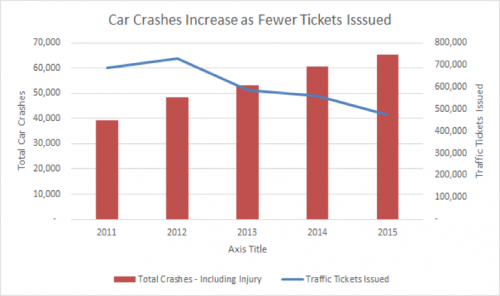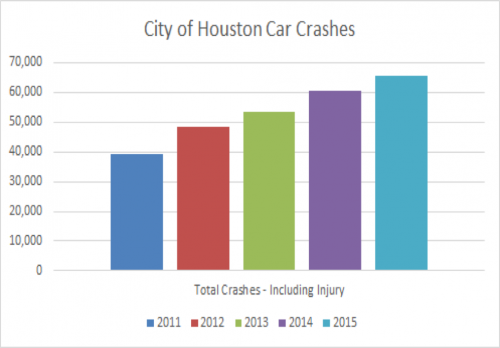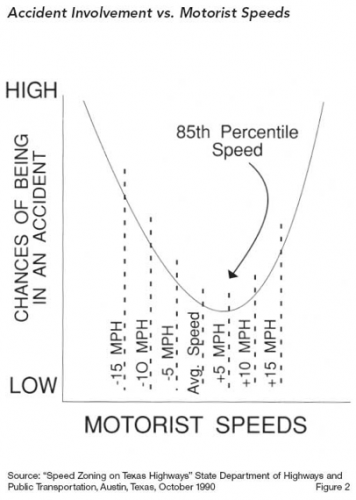 by Jay Wall
by Jay Wall
Car crashes in Houston increased 67{997ab4c1e65fa660c64e6dfea23d436a73c89d6254ad3ae72f887cf583448986} from 2011 to 2015, more than 26,000 crashes a year. Traffic delays have increased along with the rise in accidents. The delays have very real costs – 61 hours in delays, $1,490 in lost time, and 29 gallons of wasted fuel per auto per year, according to the Texas A&M Transportation Institute. What’s the solution? The City of Houston has severe financial problems, so new roads, miles of trains, and other budget busters are not a realistic option. Realistic solutions should take advantage of the 80/20 rule to create efficient, budget friendly solutions.
Italian economist Vilfredo Pareto, noted, among other things, that 20{997ab4c1e65fa660c64e6dfea23d436a73c89d6254ad3ae72f887cf583448986} of the peapods in his garden produced 80{997ab4c1e65fa660c64e6dfea23d436a73c89d6254ad3ae72f887cf583448986} of the peas. In business, it’s often heard that 20{997ab4c1e65fa660c64e6dfea23d436a73c89d6254ad3ae72f887cf583448986} of the salespeople produce 80{997ab4c1e65fa660c64e6dfea23d436a73c89d6254ad3ae72f887cf583448986} of the sales or 80{997ab4c1e65fa660c64e6dfea23d436a73c89d6254ad3ae72f887cf583448986} of the business comes from 20{997ab4c1e65fa660c64e6dfea23d436a73c89d6254ad3ae72f887cf583448986} of the clients. In Houston, 80{997ab4c1e65fa660c64e6dfea23d436a73c89d6254ad3ae72f887cf583448986} of the traffic problems come from 20{997ab4c1e65fa660c64e6dfea23d436a73c89d6254ad3ae72f887cf583448986} of the drivers – and we all know exactly who they are. The driver doing 15 miles an hour below the flow of traffic in a freeway passing lane; the driver lane jumping at an entrance ramp and coming to a complete stop to enter the ramp; and the slow driver who shouldn’t be on a freeway at all. Solving these three problems is not a budget buster. It may be a revenue enhancer.
One major factor in the rise in traffic accidents has been that even as more people have moved into Houston, the Houston Police Department has backed off traffic enforcement. In the same period from 2011 to 2015 while traffic accidents spiked 67{997ab4c1e65fa660c64e6dfea23d436a73c89d6254ad3ae72f887cf583448986}, traffic citations dropped 31{997ab4c1e65fa660c64e6dfea23d436a73c89d6254ad3ae72f887cf583448986}.
 Obviously that drop wasn’t due to Houstonians becoming better drivers. While ticket revenue shouldn’t be a budget balancer, increased enforcement with increased fines is definitely not a budget buster.
Obviously that drop wasn’t due to Houstonians becoming better drivers. While ticket revenue shouldn’t be a budget balancer, increased enforcement with increased fines is definitely not a budget buster.
Enforcement of minimum speed limits would be more effective at preventing accidents than increased enforcement of maximum speed limits, while also improving the flow of traffic.
Traffic moving 5 to 10 mph below the posted speed limit is more likely to cause an accident than traffic moving 5 to 10 mph above the posted speed limit. Traffic moving 15 mph below the posted speed limit (a typical minimum speed limit level) is approximately twice as likely to cause an accident as traffic moving 15 mph above the limit.
Lack of lane discipline makes the issue of dangerously slow drivers even worse. In a paper presented at the 50th annual Transportation Research Forum, Reinhard Clever, Ph.D. noted that cars being forced to zigzag around slower moving vehicles “almost equally distributed over all freeway lanes” may be the leading factor in rising fatality rates as speed limits are raised on freeways. A study in Michigan from 2007 found that posting “Keep Right Pass Left” signs did not affect driver behavior without enforcement. For a “keep right except to pass” policy to be effective, the public has to believe it will be enforced.
Anyone who has driven more than 10 miles on a Houston freeway during the workday has seen the lane jumpers, drivers who pass a long line of cars in the exit lane, come to a complete stop in the driving lane and muscle their way onto the exit. The stretch from Gulfon/Fournace road on the West Loop, north to the SW Freeway, is one such stretch. Another is the junction of 59 North and I-45 South. Name a freeway interchange in Houston and there is probably a similar situation. The HPD could enforce existing solid white lines at less than zero cost. Particular problem areas could be enhanced with longer lane change prohibitions.
The Texas A&M Transportation Institute’s Mobility Scorecard noted that “Getting more productivity out of the existing road and public transportation systems is vital to reducing congestion and improving travel time reliability.” This is never more true than today in a financially strapped, traffic weary Houston. I’ve suggested a few possible solutions and there are likely other improvements to be made. The common theme is targeting the 20{997ab4c1e65fa660c64e6dfea23d436a73c89d6254ad3ae72f887cf583448986} of drivers that cause 80{997ab4c1e65fa660c64e6dfea23d436a73c89d6254ad3ae72f887cf583448986} of the problems and aggressively enforcing the rules that slow traffic, causing accidents.
J.W. “Jay” Wall is a commercial real estate broker, specializing in tenant representation.


I pulled the data back in February of this year. It shows that as of 2015 the Houston Police Department (and Code enforcement officers) wrote over 269,705 fewer Traffic Citations then they did from their high of 2008.
Citations Issued by HPD 4/1/2006 to 02/28/2016
Citations Cases
2016 (1/1 through 2/28) 46,270 75,423
2015 301,793 490,576
2014 340,437 560,876
2013 368,984 608,658
2012 432,057 715,903
2011 451,566 755,980
2010 520,142 885,599
2009 531,522 920,631
2008 571,498 1,027,735
2007 511,662 905,080
2006 (4/1 through 12/31) 446,016 784,281
The Citation is the paper ticket that the violations go on. (i.e. speeding, no insurance, etc.) With over 200,000 fewer traffic stops think about all of the Felony/Misdeameanor arrests that are not made because HPD is not enforcing traffic laws. Remember the Oklahoma bomber was caught because of a traffic stop.
For disclosure…I make a living representing people on traffic tickets.
Paul,
Maybe you’ve hit on something regarding misdemeanor/felony cases filed as result of traffic stops: The case filings in the county criminal courts have been declining since 2009 which was a peak year. The projections are that this year will show fewer filings that the previous year. Your chart shows the most tickets in 2008 and declining in lock step with county court misdemeanors.
It’s simple, it’s a man power issue! Every Department in the country is struggling to hire enough people to do he job. When your going from call to call and you don’t have enough people to go to the calls holding, things like traffic stops get put on the back burner.
Paul,
That is not the case at all. Officers are not enforcing Traffic laws because of all the hangover pain of the Parker administration. 1. Lack of overtime, and 2. a hostile environment towards the officers from the municipal court.
Mr Wall,
AMEN to Your article!
Traffic enforcement should be driven by safety.
If there is an area with a high number of accidents, more traffic enforcement should be occur in that area.
I drive south on the ship channel bridge daily during morning rush hour. There is a minimum of one sometimes two “Commercial Vehicle Enforcement” officers on 610 at that time. This has nothing to do with safety and I am certain has everything to do with a Federal Grant.
Truck enforcement is there because of the dangers of very hard large heavy truck coming down a very steep bridge. Its all about Safety.
Paul Kubosh,
I hate to disagree with you but I must in this case. The Commercial Vehicle Enforcement units on Hwy 225 and Hwy 146 (be they Pasadena, Deer Park, La Porte or Seabrook) are not there because of safety. Not at all. Not even close.
They are there for revenue. I might not know much about inner city traffic enforcement but I do know about 225/146. I can’t really give you specifics online because of my current elected position but if you want to talk on the phone, give me a call.
DJ
Are the CVE units writing tickets for violations? Even if revenue is made, they are still improving safety. I recall when Houston started the CVE program that some commercial truckers were vehemently opposed because “I don’t have time to inspect my truck every day” and “it costs too much to get the brakes fixed, and I have kids to feed”. Far too many commercial vehicle owners could not care less about safety, so the CVE programs are required.
Amen! Instead of ticketing nominal speeders and setting speed traps, police should be upholding the laws that make entering I-69, I-45, etc., from anywhere on the 610 Loop (for one) infuriating and unnecessarily time consuming. Great article. Thank you for bringing this issue forward for the public’s view.
Jay wall is a civic minded Houstonian who has written a number of articles that have been published in various media outlets. As usual, this article is very well written and researched., but the title is lousy. A better title would have been: Enforce Minimum Speed Limits to Reduce Car Crashes and Improve the Flow of Traffic.
The city considers traffic fines as a cash cow.
That cash cow helps the city pay for police salaries, police pensions and to hire more cops. Then why are Houston cops writing fewer traffic citations? It has little to do do with a shortage of police officers.
Over the years I’ve come to know many Houston officers. Almost all of them told me they hatted to stop people for driving violations. When stopping an otherwise law abiding citizen, they are often treated with contempt. If the traffic violator contests the citation, the officer has to appear in court. Many cops simply fail to show up in court.
So the reason cops are writing fewer traffic citations is because doing so is a pain in the ass. If it were not that a number of Houston officers are assigned to traffic enforcement, there would hardly be any tickets handed out at all.